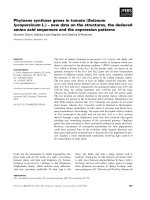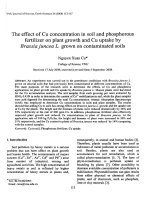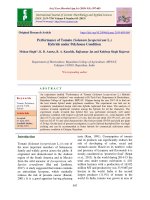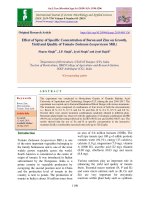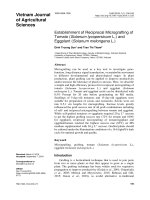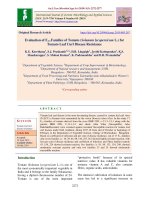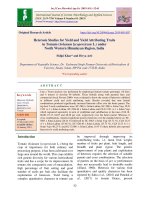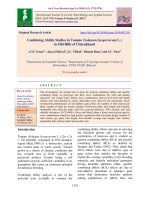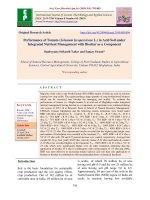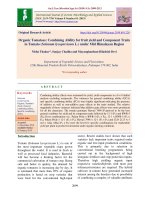Effect of spacing and training on vegetative growth characteristics and yield of tomato (Solanum lycopersicum L.) grown in polyhouse
Bạn đang xem bản rút gọn của tài liệu. Xem và tải ngay bản đầy đủ của tài liệu tại đây (194.12 KB, 8 trang )
Int.J.Curr.Microbiol.App.Sci (2017) 6(5): 1969-1976
International Journal of Current Microbiology and Applied Sciences
ISSN: 2319-7706 Volume 6 Number 5 (2017) pp. 1969-1976
Journal homepage:
Original Research Article
/>
Effect of Spacing and Training on Vegetative Growth Characteristics and
Yield of Tomato (Solanum lycopersicum L.) Grown in Polyhouse
Satveer Yadav, K.D. Ameta*, S.K. Sharma, R.B. Dubey, R.S. Rathore,
Hareram Kumar and V.K. Kapuriya
Rajasthan College of Agriculture, Maharana Pratap University of Agriculture and Technology,
Udaipur 313001, Rajasthan, India
*Corresponding author
ABSTRACT
Keywords
Tomato, Training
level, Growth,
Yield, Plant
spacing,
Polyhouse.
Article Info
Accepted:
19 April 2017
Available Online:
10 May 2017
An experiment was carried out to study the effect of spacing and training on vegetative
growth characteristics and yield of tomato under polyhouse. The experiment was
comprised of four levels of spacing and three levels of training with Factorial Completely
Randomized Design. The experimental results revealed that maximum plant height
(241.18 cm), stem diameter (7.42 cm), number of branches per plant (26.67), leaf area
(325.84 cm2), number of clusters per plant (18.63), number of fruits per cluster (6.31),
number of fruits per plant (112.44), fruit weight (106.93 g), volume of fruit (110.70 cc),
specific gravity (0.97gcm3) and yield per plant (12.07 kg) were recorded on wider spacing
S4 (60 x 60 cm). The maximum stem diameter (7.36 cm), number of branches per plant
(24.53), number of clusters per plant (15.93), total yield per plant (8.48 kg) and yield per
square meter (20.96 kg) were exhibited by T 3 (triple stem training). The maximum yield
per square meter was observed in interaction S2T3 (45 x 45 cm, triple stem). while number
of branches per plant (30.33), number of clusters per plant (19.67), number of fruits per
cluster (6.77), number of fruits per plant (125.87) and total yield per plant (12.88 kg) were
observed in treatment combination S4T2 (60 x 60 cm, double stem training).
Introduction
Tomato (Solanum lycopersicum L.) is one of
the most important vegetable crops in the
India. It belongs to family Solanaceae with
diploid chromosome number (2n=24) and is a
typical self-pollinated day neutral plant.
Tomato has originated from South America
(Mexico and Peru). In tomato there are two
types of growth habit have been found viz.,
determinate (generally grown under open
field condition) and indeterminate (normally
grown under poly house condition). It is
cultivated in both temperate and tropical
regions of the world. It is consumed in a
various ways like fresh in salads and
sandwiches, cooked or processed in ketchup,
sauces, paste, puree, juices or dried powder.
Tomato plays an important role in human
nutrition by providing essential amino acids,
vitamins and minerals (Sainju et al., 2003)
and it is considered a protective food because
of its particular nutritive value, as it provides
important nutrients such as lycopene, betacarotene, flavonoids, vitamin „C‟ and
hydroxycinnamic
acid
derivatives.
Furthermore, this crop has achieved
tremendous popularity especially in recent
1969
Int.J.Curr.Microbiol.App.Sci (2017) 6(5): 1969-1976
years with the discovery of lycopene‟s antioxidative activities and anti-cancer functions
(Wu et al., 2011; Raiola et al., 2014). Edible
portion of tomato contains energy 18 kcal,
protein 0.95 g, fat 0.11 g, carbohydrate 4.01
g, total sugar 2.49 g, Ca 11.0 mg, Fe 0.68 mg,
Mg 9.0 mg, P 28.0 mg, K 218.0 mg, Na 11.0
mg, Zn 0.14 mg, thiamin 0.036 mg, riboflavin
0.022 mg, carotene (Vit. A) 320 IU, vitamin
B 60.079 mg, ascorbic acid 31mg per 100 g
pulp of fruit. The cultivation of vegetables
under polyhouse is increasing in the state. In
polyhouse, microclimate surrounding the
plant is controlled partially or fully, as per the
requirement of the plant species (Mishra et
al., 2010). In this study the main emphasis
was given on appropriate cultural practices
such as plant densities and training systems in
order to enhance the production per unit area
by utilizing the available space and utilization
of the resources.
Materials and Methods
treatment combinations. Beds were irrigated
when necessary during the growing season.
Fertilizers were applied @ 200: 120: 120 kg
NPK
ha-1,
respectively along with
micronutrient for raising healthy crop. All the
management practices including hoeing;
weeding and other horticultural operation
were performed. Insecticide and fungicide
spray were applied whenever it appeared
necessary throughout the growing season.
Plants were vertically trained with single stem
(T1), double stem (T2), triple stem (T3) per
plants as per treatment combinations. The
observations on plant height (cm), stem
diameter (cm), number of branches per plant,
leaf area (cm2), days to first harvesting,
number of clusters per plant, number of fruits
per cluster, number of fruits per plant, fruit
weight (g), fruit diameter (cm), volume of
fruit (cc), specific gravity (g/cm3), total yield
per plant (kg) and yield per square meter (kg)
were recorded from five randomly selected
plants of each replication.
To assess effect of spacing and training on
vegetative growth characteristics and yield of
tomato grown under polyhouse an experiment
was laid out at Hi-Tech Horticulture Unit,
Department of Horticulture, Rajasthan
College of Agriculture, Udaipur (Rajasthan)
during August, 2015 to March, 2016. The size
of the polyhouse was 28 m × 32 m (896sq.m)
covered with aluminate sheet and ultra violet
stabilized low density polyethylene sheet
having 200 micron thickness. The experiment
was comprised of four levels of spacing, i.e.,
45 cm × 30 cm (S1), 45 cm × 45 cm (S2), 45
cm× 60 cm (S3) and 60 cm × 60 cm (S4) and
three levels of training, viz., single stem (T1),
double stem (T2), triple stem (T3). The
seedlings were raised on soil-less media
(mixture of vermiculite, perlite and cocopit)
in plug tray having cells of 2” in size. Four
week old seedlings at 4-5 true leaf stage were
transplanted at 45 x 30 cm, 45 x 45 cm, 45 x
60 cm and 60 x 60 cm according to different
The plant height was measured in centimeter
from the ground level to extreme growing tip
of the main stem with the help of meter scale
at the time of final harvest. Stem diameter
was measured in centimeter at 2 cm above the
ground level of plant and diameter of stem
was measured with the help of vernier
calipers at the stage of final harvesting. Total
number of branches of individual plants was
counted at the stage of final harvesting. Leaf
area per plant was determined using leaf area
meter, LICOR-3100 USA. Leaf area was
measured at the time of final harvesting and
expressed as cm2. The days from the date of
transplanting to the date of first harvesting in
each treatment were recorded. The difference
of the date of transplanting and date of first
harvesting was calculated for the number of
days required for harvesting. Total number of
clusters per plant was counted on plants and
averages were computed. Total number of
fruits per cluster was counted from randomly
1970
Int.J.Curr.Microbiol.App.Sci (2017) 6(5): 1969-1976
selected 10 clusters on all the five tagged
plant and average was calculated. The number
of fruits was counted separately on the five
randomly selected plants on each date of
harvest till all the fruits were harvested. Then
average number of fruits per plant was
calculated after dividing total number of fruit
by five. Randomly selected five fruits in each
treatment were weighed with the help of
digital balance and the mean weight of fruit
was calculated and expressed in gram. Same
five fruits were used for measuring fruit
diameter. The diameter of the fruit was
measured with the help of vernier callipers in
centimeter and average was calculated. Same
five fruits which were used for recording
weight of fruits were used for measuring fruit
volume. Volume was measured by water
displacement method. For this purpose, fruits
were dipped in a full filled jar of water and
the water displaced by the fruits was collected
and measured by graduated glass jar and
average volume of fruit was calculated.
Specific gravity of the fruit was worked out
by dividing the weight of the fruit by the
volume of the same fruit and was expressed
as gram per cubic centimeter. The fruits
harvested from five tagged plants were
weighed separately with the help of digital
balance on each harvest and sum total of each
harvesting was computed for getting total
yield per plant and expressed in kg. The yield
of fruits per square meter was calculated by
multiplying the average yield of plant and
number of plants per square meter and
expressed in kilogram per square meter.
Results and Discussion
Data (Table-1) reveled that maximum plant
height (241.18 cm), stem diameter (7.42 cm),
number of branches per plant (26.67) and leaf
area (325.84 cm2) were recorded at widest
spacing i.e. treatment S4 (60 cm x 60 cm)
compared to others. This may be due to the
availability of more space for individual plant
growth, more leaf area, ample sun light and
aeration under wider spacing. These findings
were in conformity with the work of Bhattarai
et al., (2015) and Singh and Kumar (2005) in
cherry tomato. Among the method of training,
the maximum stem diameter (7.36 cm) and
number of branches per plant (24.53) were
recorded in treatment T3 (triple stem training).
These results are in accordance with the
findings of Jovicich et al., (1998) in sweet
pepper grown in polyhouse. While maximum
leaf area (319.72 cm2) was recorded in
treatment T1 (single stem), the lowest day to
first harvesting was also recorded in treatment
T1 (single stem). The present results are
supported by the findings of Hesami et al.,
(2012) in semi determinate tomato. Among
the treatment combinations, maximum
number of branches per plant (30.33) was
observed in S4T3 (60 cm × 60 cm and triple
stem), while lowest days to first harvesting
(83.00) was observed in S1T1 (45 cm × 30 cm
and single stem). Similar results were also
recorded by Ara et al., (2007) in tomato.
The plant spacing significantly influenced
yield attributed characters in tomato. Data
(Table-2) revealed that maximum number of
clusters per plant (18.63) and number of fruits
per plant (112.44) was reported at widest
spacing, S4 (60 cm × 60 cm) as compared to
lowest in S1 (45 cm × 30 cm). This might be
due to more fruit set, more photosynthesis as
it produces more plant height at wider
spacing. Similar trend was observed by
Mantur and Patil (2008), Bhattarai et al.,
(2015) and Rajendra et al., (2013) in tomato.
Maximum number of fruits per cluster (6.31)
at wider spacing S4 (60 cm x 60 cm) and
minimum in close spacing (45 cm x 30 cm).
These findings are in accordance with the
findings of Rajendra et al., (2013) in tomato
and Singh and Kumar (2005) in cherry
tomato. The maximum fruit weight (106.93 g)
and yield per plant (12.07 kg) was observed at
widest spacing treatment, S4 (60 cm x 60 cm).
1971
Int.J.Curr.Microbiol.App.Sci (2017) 6(5): 1969-1976
Table.1 Effect of spacing and training on plant height, stem diameter, number of branches per
plant, leaf area, days to first harvesting in polyhouse grown tomato
Treatment
Spacing (S)
S1 (45x30 cm)
S2 (45x45 cm)
S3 (45x60 cm)
S4 (60x60 cm)
SEm±
CD at 5%
Training (T)
T1
T2
T3
SEm±
CD at 5%
Interaction (S x T)
S1T1
S1T2
S1T3
S2T1
S2T2
S2T3
S3T1
S3T2
S3T3
S4T1
S4T2
S4T3
SEm±
CD at 5%
Plant height
(cm)
Stem
diameter
(cm)
Number of
branches per
plant
Leaf area
(cm2)
Days to
first
harvesting
188.38
217.70
235.90
241.18
5.197
15.169
6.86
7.14
7.25
7.42
0.062
0.180
16.64
21.16
24.02
26.67
0.144
0.421
302.23
313.09
318.07
325.84
1.449
4.229
84.56
86.33
85.11
85.78
0.617
NS
229.06
215.83
217.48
4.501
NS
6.97
7.18
7.36
0.053
0.156
18.63
23.20
24.53
0.125
0.364
319.72
317.25
307.46
1.255
3.663
84.33
86.25
85.75
0.534
1.560
202.54
166.11
196.50
226.67
218.74
207.67
240.65
234.97
232.08
246.40
243.48
233.67
9.001
NS
6.55
6.79
7.23
6.99
7.19
7.26
7.08
7.32
7.36
7.26
7.42
7.59
0.107
NS
15.00
17.07
17.87
18.80
21.73
22.93
20.07
25.00
27.00
20.67
29.00
30.33
0.250
0.7290
306.71
304.07
295.92
316.69
315.86
306.71
323.28
318.09
312.83
332.18
330.97
314.38
2.510
NS
83.00
86.00
84.67
87.00
86.00
86.00
84.33
84.00
87.00
83.00
89.00
85.33
1.069
3.1202
1972
Int.J.Curr.Microbiol.App.Sci (2017) 6(5): 1969-1976
Table.2 Effect of spacing and training on number of clusters per plant, number of fruits per
cluster, number of fruits per, fruit weight, fruit diameter, volume of fruit, specific gravity, total
yield per plant and yield per square meter in polyhouse grown tomato
Treatment
Number
of
clusters
per
plant
Spacing (S)
S1(45x30cm)
12.28
S2(45x45 cm)
15.08
S3(45x60 cm)
16.37
S4(60x60 cm)
18.63
SEm±
0.167
CD at 5%
0.488
Training(T)
T1
14.94
T2
15.89
T3
15.93
SEm±
0.145
CD at 5%
0.423
Interaction (S x T)
S1T1
12.53
S1T2
12.33
S1T3
11.97
S2T1
14.03
S2T2
14.93
S2T3
16.27
S3T1
15.83
S3T2
16.63
S3T3
16.63
S4T1
17.37
S4T2
19.67
S4T3
18.87
SEm±
0.290
CD at 5%
0.8456
Number
of fruits
per
cluster
Number
of fruits Fruit
per
weight
plant
(g)
Specifi
Fruit Volume
c
diameter of fruit gravity
(cm)
(cc) (g/cm3)
Total
yield
per
plant
(kg)
Yield
per
square
meter
(kg)
3.79
5.22
5.68
6.31
0.136
0.397
46.10
76.13
90.03
112.44
1.003
2.927
80.09
93.85
98.11
106.93
0.308
0.899
10.70
11.26
12.41
11.99
0.106
0.310
84.13
97.93
102.16
110.70
0.399
1.164
0.95
0.96
0.96
0.97
0.003
0.009
3.50
6.89
9.61
12.07
0.104
0.302
15.54
20.42
21.35
20.11
0.228
0.667
4.95
5.50
5.30
0.118
0.344
72.15
86.59
84.78
0.868
2.535
96.91
94.84
92.48
0.267
0.779
11.67
11.65
11.46
0.092
NS
100.52
99.18
96.49
0.345
1.008
0.96
0.96
0.96
0.003
NS
7.14
8.43
8.48
0.090
0.262
16.97
20.13
20.96
0.198
0.578
3.10
3.67
4.60
5.03
5.43
5.20
5.17
6.13
5.73
6.50
6.77
5.67
0.236
0.6881
37.65
45.27
55.37
64.93
79.49
83.97
78.28
95.75
96.06
107.73
125.87
103.73
1.737
5.0692
82.11
79.60
78.55
95.52
93.93
92.09
101.67
99.67
93.00
108.33
106.17
106.29
0.533
1.5571
11.50
10.42
10.19
11.25
11.28
11.25
12.09
12.63
12.52
11.83
12.25
11.90
0.184
0.5361
85.04
84.27
83.08
99.35
98.33
96.10
105.43
104.52
96.54
112.28
109.57
110.24
0.690
2.0153
0.97
0.94
0.95
0.96
0.96
0.96
0.96
0.95
0.96
0.96
0.97
0.96
0.005
NS
3.15
3.30
4.04
5.49
7.27
7.92
8.02
10.28
10.52
11.89
12.88
11.44
0.179
0.5237
14.00
14.68
17.95
16.25
21.54
23.46
17.82
22.84
23.38
19.80
21.46
19.07
0.396
1.1551
The similar findings were reported by Biradar
et al., (2014) in capsicum, Harish and Patil
(2011) and Sharma et al., (2011) in tomato.
Maximum average fruit diameter (12.41 cm)
was observed in wider spacing, S3 (45 cm x
60 cm). Similar results were obtained in
tomato by Bhahadur and Singh (2005). The
highest yield per m2 (21.35 kg) was obtained
in treatment S3 (45 cm × 60 cm) followed by
20.42 kg per m2 in treatment S2 (45 cm × 45
cm). It might be due to effective utilization of
land, nutrients and sunlight. The results are in
conformity with findings of Mantur and Patil
(2008), Dasgan and Abak (2003) and Cebula
(1995). The maximum specific gravity (0.97
g/cm3) and volume of fruit (110.70 cc) were
recorded in wider spacing i.e. S4 (60 cm x 60
cm). The present results are supported by the
findings of Muhammad and Singh (2007) in
tomato.
1973
Int.J.Curr.Microbiol.App.Sci (2017) 6(5): 1969-1976
Among the method of training, the maximum
number of clusters per plant (15.93), total
yield per plant (8.48 kg) was observed in T3
(triple stem) and lowest (7.14 kg) in T1 (single
stem), whereas maximum fruit weight
(96.91g) in T1 (single stem) this observation
was in close conformity with the results of
Khoshkam et al., (2014) and Razzak et al.,
(2013) in tomato and Lal et al., (2014) in
capsicum. The maximum number of fruits per
plant (86.59) and number of fruits per clusters
(5.50) was observed in T2 (double stem),
these findings of the present investigation are
in conformity with findings of Dasgan and
Abak (2003) in bell peppers. The fruit
diameter and specific gravity showed nonsignificance results. But the volume of fruit
was significantly affected by training level
with maximum volume of fruit (100.52 cc) in
T1 (single stem). The present results are
supported by the findings of Muhammad and
Singh et al., (2007) in tomato. Maximum
yield per square meter (20.96 kg) was
observed in T3 (triple stem), which was at par
with T2 (double stem). The present results are
supported by the finding of Mazed et al.,
(2015) and Alsadon et al., (2013) in tomato.
Among all the treatment combinations, S4T2
(60 cm x 60 cm and double stem) showed
maximum number of clusters per plant
(19.67), number of fruits per cluster (6.77)
and total yield per plant (12.88 kg), while
S4T1 (60 cm x 60 cm and single stem) showed
maximum fruit weight (108.33 g) and
maximum fruit diameter (12.63 cm) was
reported in S3T2 (60 cm x 45 cm and double
stem). Similar results were also recorded by
Mantur and Patil (2008) in tomato, Dasgan
and Abak (2003) in peppers, Lal et al., (2014)
in capsicum, Charlo et al., (2007) in cherry
tomato, Ara et al., (2007) in indeterminate
tomato. Maximum number of fruits per plant
(125.87) was noticed in S4T2 (60 cm x 60 cm
and double stem) treatment combination and
minimum (37.65) in S1T1 (45 cm x 30 cm and
single stem) treatment combination. Similar
results were reported by Kumar and Chandra
(2014) in capsicum. The maximum volume of
fruit (112.28 cc) observed in S4T1 (60 cm x 60
cm and single stem) treatment combination.
Similar finding was quoted by Ameta et al.,
(2014) in capsicum. The maximum yield per
square meter (23.46 kg) was recorded in S2T3
(45 cm x 45 cm and triple stem), this trend of
interaction effect was also reported by
Maniutiu et al., (2010).
References
Alsadon, A., Wahb-Allah, M., Abdel-Razzak,
H. and Ibrahim, A. 2013. Effects of
pruning systems on growth fruit yield
and quality traits of three greenhousegrown bell pepper (Capsicum annuum
L.) cultivars. Australian J. Crop Sci.,
7(9): 1309-1316.
Ameta, K.D., Kaushik, R.A., Dubey, R.B. and
Pareek, S. 2014. Effect of training and
crop geometry on yield attributes and
yield of poly house grown “Natasha”red
capsicum.
Int.
J.
Innovative
Horticulture, 3(1): 67-70.
Anonymous. 2014. www.nhb.gov.in, Indian
Horticulture database 2014. pp 4-181.
Ara, N., Bashar, M.K., Begum, S. and Kakon,
S.S. 2007. Effect of spacing and stem
pruning on the growth and yield of
tomato. Int. J. Sustainable Crop
Production, 2(3): 35-39.
Bahadur, A. and Singh, K.P. 2005.
Optimization of spacing and drip
irrigation scheduling in indeterminate
tomato
(Lycopersicon
esculentum
Mill.). Indian J. Agri. Sci., 75(9): 563565.
Bhattarai, P., Kaushik, R.A., Ameta, K.D.,
Jain, H.K., Kaushik, M.K. and Sharma,
F.L. 2015. Effect of plant geometry and
fertigation on growth and yield of
cherry tomato (Solanum lycopersicon
var. cerasiforme) under zero energy
1974
Int.J.Curr.Microbiol.App.Sci (2017) 6(5): 1969-1976
poly house conditions. Indian J.
Horticulture, 72(2): 297-301.
Biradar, M.S., Patil, A.A., Mantur, S. M. and
Mannikeri, I.M. 2014. Influence of
growing environment and planting
geometry on yield and yield attributes
of capsicum (Capsicum annuum L.var.
grossum Sendt.) genotypes. Karnataka
J. Agri. Sci., 27(2): 202-207.
Cebula, S. 1995. Optimization of plant and
shoot spacing in greenhouse production
of sweet pepper. Acta Horticulturae,
412(2): 321- 328.
Charlo, H.C.O., Castoldi, R., Ito, L.A.,
Fernandes, C. and Braz, L.T. 2007.
Productivity of Cherry tomatoes under
protected cultivation carried out with
different types of pruning and spacing.
Acta Horticulture, page 323 – 326.
Dasgan, H.Y. and Abak, K. 2003. Effects of
plant density and number of shoots on
yield and fruit characteristics of peppers
grown in glasshouses. Turkey J. Agri.,
27: 29-35
Harish, S. and Patil, B.N. 2011. Investigations
on growing condition, spacing and
calcium sprays on seed yield, quality
and storability of tomato (Solanum
lycopersicum L.) Seeds M.Sc. (Agri.)
Thesis. University of Agricultural
Sciences, Dharwad.
Hesami, A., Khorami, S.S. and Hosseini, S. S.
2012. Effect of shoot pruning and
flower thinning on quality and quantity
of
semi-determinate
tomato
(Lycopersicon
esculentum
mill.).
Notulae Scientia Biologicae, 4(1): 108111.
Jovicich, E., Cantliffe D.J. and Hochmuth,
G.J. 1998. Plant density and shoot
pruning on yield and quality of a
summer greenhouse sweet pepper crop
in north-central Florida.
Khoshkam, S., Seyedi, Z. and Ahmad, A.
2014. The impact of different plant
training systems on quantitative and
qualitative parameters of greenhouse
tomato cultivars. Int. J. Farming and
Allied Sci., 3(6): 659-663.
Kumar, U. and Chandra G. 2014. Effect of
spacing and training levels on growth
and yield of capsicum under polyhouse
in North Bihar conditions. J. Hill Agri.,
5(1): 9-12.
Lal, M., Kanwar, H.S. and Kanwar, R. 2014.
Impact of spacing and training on seed
yield of capsicum, (Capsicum annuum
L.) under protected conditions. Int. J.
Farm Sci., 4(3): 42-48.
Maniutiu, D., Sima, R., Apahidean, A.S.
Pahideana, M. and Ficior, D. 2010. The
influence of plant density and shoot
pruning on yield of bell pepper
cultivated in plastic tunnel. Bull.
UASVM Horticulture, 67(1): 259-263.
Mantur, S.M. and Patil, S.R. 2008. Influence
of spacing and pruning on yield of
tomato grown under shade house.
Karnataka J. Agri. Sci., 21(1):,97-98.
Mazed, H.E.M.K., Akand, H., Haque, N.,
Pulok, A.I. and Partho, S.G. 2015. Yield
and economic analysis of tomato
(Lycopersicon esculentum Mill) as
influenced by potassium and stem
pruning. Int. J. Scientific and Res.
Publications, 5(1): 1-5.
Mishra, G.P., Singh, N., Kumar, H. and
Singh, S.B. 2010. Protected cultivation
for food and nutritional security at
Ladakh. J. Defense Sci., 61(2): 219-225.
Muhammad, A. and Singh, A. 2007. Intrarow spacing and pruning effect on fresh
tomato yield in Sudan Savanna of
Nigeria. J. Plant Sci., 2(2): 153-161.
Raiola, A., Ragino, M.M., Calafior, R.,
Frusciante, L. and Barone, A. 2014.
Enhancing the human promoting effects
of tomato fruit fortified food.
Corporation Mediators of inflammation.
doi:10.1155/2014/139873.
Rajendra, B.N., Patil, S.R., Swamy, K.M. and
Anasubai, G.H. 2013. Impact of
1975
Int.J.Curr.Microbiol.App.Sci (2017) 6(5): 1969-1976
different spacing on growth and yield of
indeterminate tomato grown under
shade house. The Asian J. Horticulture,
8(1): 377-378.
Razzak, H.A., Ibrahim, A., Allaha, M. W. and
Alasadon, A. 2013. Response of cherry
tomato (Solanum lycopersicum var.
cerasiforme) to pruning system and
irrigation rates under green house
condition. Asian J. crop sci., page 1-11.
Sainju, M.U., Dris, R. and Singh, B. 2003.
Mineral nutrition of tomato. Food Agri.
Environ., 1(2): 176-183.
Sharma, A., Kaushik, R.A., Sarolia, D.K. and
Sharma, R.P. 2011. Response of
cultivars, plant geometry and methods
of
fertilizer
application
on
parthenocarpic cucumber (Cucumis
sativus L.) under zero energy polyhouse
condition during rainy season. Veg. Sci.,
37(2): 184-186.
Singh, B. and Kumar, M. 2005. Effect of
plant spacing and stem pruning on
growth and yield of cherry tomato in
greenhouse. Haryana J. Horticultural
Sci., 34(1/2): 179-180.
Wu, Z., Sun, S., Wang, F. and Guo, D. 2011.
Establishment of regeneration and
transformation system of tomato
(Lycopersicon esculentum Mill.). J.
Biotechnol., 3 (1): 53-60.
How to cite this article:
Satveer Yadav, K.D. Ameta, S.K. Sharma, R.B. Dubey, R.S. Rathore, Hareram Kumar and
V.K. Kapuriya. 2017. Effect of Spacing and Training on Vegetative Growth Characteristics and
Yield
of
Tomato
(Solanum
lycopersicum
L.)
Grown
in
Polyhouse.
Int.J.Curr.Microbiol.App.Sci. 6(5): 1969-1976. doi: />
1976
